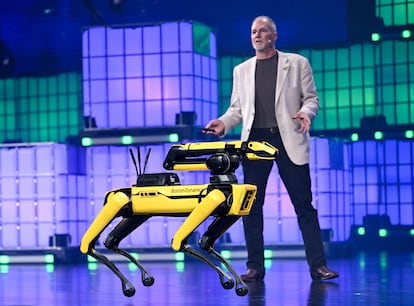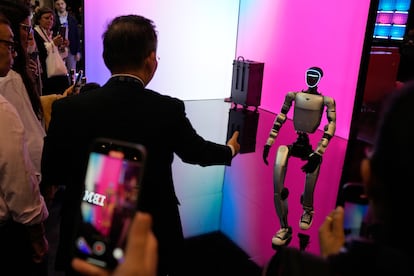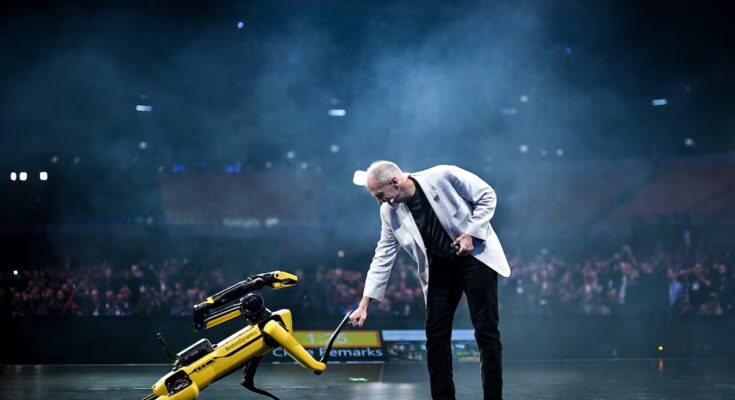What had the most flashes at the Web Summit in Lisbon, one of the most important technological events in the world, was not any of the CEOs present, nor the famous guests – the most followed TikToker in the world Khaby Lameo or the former tennis player Maria Sharapova attended – nor the local politicians: it was a robot. In this case in the shape of a dog.
Spot, the Boston Dynamics robot who in a more primitive version was reminiscent of the series Black mirrorhe raised a tunnel of flashes and cell phones behind him as if he were a Hollywood star. The robotic dog made his way to the stage and climbed the five steps to meet his creator, Robert Playter, CEO of Boston Dynamics.
The head of this company, known for its anthropomorphic and quadrupedal machines, was proud of its progress. Spot is already used in industrial plants for inspection tasks, thanks to a collection of sensors that collect all types of data. The robotic dog is used at the Fukushima plant to scan areas closed to anyone due to radioactivity. In fact, it opened some doors that hadn’t been opened since the 2011 tsunami caused the nuclear plant disaster.
Playter also gave the example of a car factory. And he showed a video of one of his robots, this time humanoid, grabbing the pieces to place them in the areas reserved for them. In this scenario the machine must deal with many types of objects, move from one place to another and adapt to possible space limitations. “They will operate in a poorly controlled environment,” the Boston Dynamics CEO stressed, adding that this type of robot could also perform assembly tasks.
His view clashes with that of Tye Brady, Chief Technology Officer of Amazon Robotics. “In the industry we have seen some extraordinary humanoids and quadrupeds that are pushing the discipline to the limit. This is noteworthy, but bringing these machines to a scale like the one Amazon needs is still very difficult. It requires advances in general artificial intelligence and above all it requires the development of tact and dexterity,” the manager said.
In an event marked by artificial intelligence, the symbiosis between it and robotics has become clear. The Web Summit, which held its tenth edition in Lisbon, received more than 70,000 participants. Among these, 1,875 investors, 74% more than last year. An increase that would have caused an unexpected influx of private jets to the Portuguese capital airport. So many that there was no landing strip for them all and controllers had to divert them to Badajoz.

Web Summit CEO Paddy Cosgrave highlighted this reason to explain the avalanche of private flights that exceeded the capacity of Lisbon Airport. Cosgrave, who resigned from his chief executive position in 2023 after a tweet in which he clearly suggested that Israel had committed war crimes in Gaza, regained his position last year. In this edition he wore a gray sweater with the word PRESS written on it, in the style of the bulletproof vests worn by correspondents in conflict zones. When questioned about this, he simply argued that journalism should be protected everywhere and that this has not happened lately.
The Web Summit CEO also highlighted that the most advanced robots that would be seen at the fair were from China. He did this before Boston Dynamics, which had no exhibitors at the show, took Spot out during the conference. Present with a stand were representatives of the Chinese manufacturer of humanoid and robotic dogs Unitree. Their cars walked, gesticulated and shook hands with the more daring spectators.
Machine learning
But it was the CEO of Boston Dynamics who shed light on the impact of artificial intelligence on machines. “AI has completely changed the way we program robots,” Playter noted. “A (human) operator, simply by remotely directing the robot, teaches it to grab an object and put it down,” he explained, showing another video, in this case of a person embedded in a controller and wearing virtual reality glasses acting as a mimicry teacher for a humanoid robot.
Traditionally, programming a machine involved extensive code development work. This could change with new AI models. “Another training formula is robotic simulations,” Playter added. “We capture a person’s movement (through a sensorized suit) and record their natural movement. Then we simulate it millions of times using software and can introduce this learning into a robot in a few days, when before it took months to program something like this.”
They are seemingly simple but highly complex tasks, such as manipulating objects. The Chief Technology Officer of Amazon Robotics also highlighted advances in machine training. “AI physical models are learning the grammar of movement, such as balance, friction and fluidity. This is the idea behind fundamental physical models. They are systems that learn from millions and millions of movements and then generalize and operate in the real world,” commented Brady, after recalling that his company currently manages more than a million robots in its warehouses.

Its purely pragmatic approach clashes with humanoid robotics, even though Amazon itself has explored this field. Referring to the anthropomorphic machines that appear to run or even roll, Brady acknowledges: “These are extraordinary feats, of course. But let’s be realistic. Many operate in a controlled environment, with limited objects and predictable tasks. At Amazon we don’t have this luxury. We operate in the real world and handle hundreds of thousands of different objects every year.”
For Playter the use of its humanoid and quadruped robots in the industrial sector is now possible. “We have created an electric humanoid robot for industrial and logistics applications. It has superhuman strength and movement capabilities. Its joints can rotate 360 degrees. It will be able to lift up to 30 kilos, will have three hours of autonomy and will be able to change its own batteries.” This machine will be dedicated to tasks of collecting and depositing objects in circumstances unfavorable for people, such as in environments with very high or very low temperatures.



